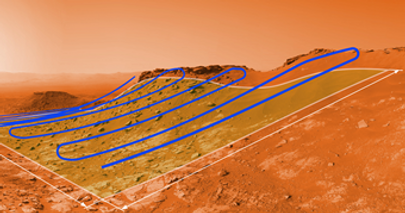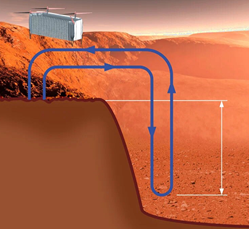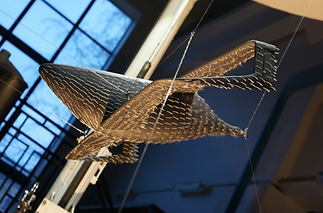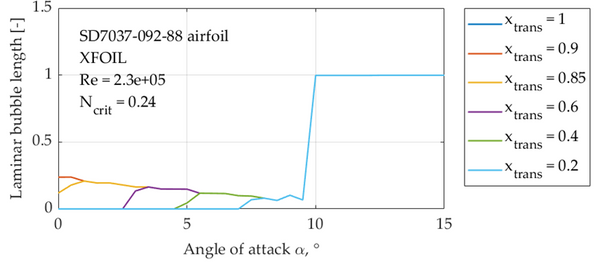LEMFEV
LONG ENDURANCE MARS EXPLORATION FLYING VEHICLE

Our Publications
Here, you can download our papers related to the LEMFEV project.
Experimental and CFD Investigation of Directional Stability of a Box-Wing Aircraft Concept
This study explores the directional stability issues of the previously investigated light box-wing aircraft model with a pusher propeller. Solutions included the use of a ducted propeller and a series of small vertical fins. The results of wind tunnel testing were supported by CFD simulations to explain the flow behavior of each of the studied solutions. The final configuration, with a duct and a modified version of the fuselage fins, provides the required yaw stability margins for a safe flight. The paper is published by MDPI Fluids: Fluids | Free Full-Text | Experimental and CFD Investigation of Directional Stability of a Box-Wing Aircraft Concept (mdpi.com)
.jpeg)


Mars Aircraft Concept Exploration: a Literature Review
In this paper, we explored and analyzed how the design issues stemming from the Mars specific conditions have been addressed in previous studies. The design of a Martian aircraft is affected by the local low density, low speed of sound, low temperature, low Reynolds numbers, powerful dust storms, electrical phenomena, carbon dioxide carving. For a lander, Martian rugged terrain excludes the conventional take-off and landing option. The need to deliver the aircraft to Mars and expose it to the space radiation affects the aircraft aerodynamic layout, structural design, and weight specification. The target operating area, altitude, and season may significantly affect the design decisions in terms of aircraft configuration, geometry and total mass. The identified design trends, as well as the presented historical data on the previous Mars aircraft can be used as a basis for determining future Mars aircraft mission scenarios.
A Solar Wing-Tail Martian Science UAV: Design Space Exploration
This paper presents the results of parametric studies of a conventional wing-tail solar UAV, designed for a single flight on Mars. Analysis showed that due to the low intensity of solar radiation and the low atmospheric density on Mars, as well as due to the relatively high specific mass of space-qualified systems and equipment, the energy requirements of a battery-equipped UAV for flying at night (WT1) cannot be secured for an entire overnight flight.
One of the rational WT2 configurations (the wing-tail solar UAV configuration with no battery for the overnight flight) has the following characteristics and performance:
-
take-off weight = 4.3 kg
-
cruising speed = 42 m/s
-
wing area = 2.0 m2
-
the solar panels area ratio = 92 %
-
flight range = 1213 km
-
flight duration = 8 hours.
The wingspan of this UAV is 3.2 m, the wing aspect ratio is 6, and the payload mass is 1.0 kg.
The flight altitude and geographic latitude are 500 m and 20 deg, respectively, the flight is carried out in March (the most favorable conditions in terms of solar radiation intensity and winds).

Trade studies for a solar wing-tail Martian UAV, configuration WT2:
Speed, Power at propeller, Wing area, and Solar area ratio as a function of wingspan.
Payload mass = 1 kg

Configuration WT2, constraint diagram: span = 3.2, aspect ratio = 6

Configuration WT2, the take-off mass breakdown for
aspect ratio =6, latitude = 20 degrees, altitude = 500 m, payload mass = 1.0 kg
Long-Endurance Mars Exploration Flying Vehicle: A Project Brief
Aerospace | Free Full-Text | Long-Endurance Mars Exploration Flying Vehicle: A Project Brief (mdpi.com)
The paper presents specifications for our Long-Endurance Mars Exploration Flying Vehicle (LEMFEV), which we use as the design input data. The specifications are based on the analysis of previous Mars missions and scientific data collected by the operating Martian probes. The design specifications include the requirements related to the airplane’s delivery to the Martian surface; the requirements related to the Martian conditions (atmosphere and climate); and the requirements related to the scientific payload parameters and the mission flight profile.

The number of constraints shaping the feasible design area of a Martian aircraft is greater than that of an Earth aircraft. In addition to more typical constraints, the feasible design area for a Martian aircraft may be limited by the following aspects:
-
The aeroshell shape and size, with the consequence of rigid or inflatable unconventional structures posing a high risk;
-
The coupling of viscosity and compressibility effects, which is difficult to predict;
-
The launch and entry g-load, with the consequence of an increased structural weight;
-
Low temperatures and radiation, with added weight due to the protection and heating systems;
-
The need to ensure the specific conditions for the onboard scientific instrumentation (this may limit, e.g., the flight altitude and speed); this also implies that the combustion exhaust products must not contaminate scientific measurements;
-
The aeroshell center-of-gravity constraint, which may also exert a significant influence on the “big” decisions, like that of the aerodynamic layout selection.
-
Atmospheric turbulence and dust;
-
The target operating site, altitude, and season.
Potential scientific missions for a Martian aircraft include crater or boundary layer exploration, which can be performed within either a single-flight or a multiple-flight scenario. The measurements can be obtained either in flight or on the surface. The LEMFEV configuration will be defined largely by the power plant type and prescribed flight profile.
Payload assembly including booster and spacecraft (descent and carrier modules)

Injection program for the spacecraft’s departure trajectory
Rocket-based versus solar wing-tail Martian UAVs: design, analysis, and trade studies
Rocket-based versus solar wing-tail Martian UAVs: design, analysis, and trade studies (springernature.app)
In this study, a rocket-based UAV and a solar wing-tail Martian UAV were designed and assessed against a set of criteria established using a house of quality chart. For the design and analysis, MATLAB and XFLR5 were used. The uncertainty of the predicted results is related to the limited accuracy of the input data (e.g., system specifications and Martian atmospheric conditions) as well as the empirical mathematical formulations used in XFLR5.
The endurance of the rocket-based aircraft is limited by the fuel tank volume and fuel mass; however, the operating area of this aircraft is not restricted to the regions, seasons, and days with high solar irradiance. Therefore, for example, it can explore the depths of craters and canyons and, if a single soft landing option is possible, it can also serve as a stationary platform.
Theoretically, the endurance of the solar UAV is unlimited; the drawback is that it can only operate under specific atmospheric conditions. Since the solar irradiance depends on the geographic location, areocentric longitude, and albedo, the success of the mission performed by a solar UAV is highly uncertain. A suitable scientific mission for a solar single-flight UAV may be the measurement of atmospheric parameters to obtain turbulent and radiative fluxes over the lowest 2–10 km of the atmosphere. This will allow us to expand the geographical and temporal coverage of measurements currently available for the planetary boundary layer of Mars.
The results of the study extend our understanding of the capabilities of a Martian fixed-wing airplane in terms of payload mass hence its scientific value, as well as in terms of its planform geometry and airfoil shapes. The findings of this study will be applied to the design of other configurations of this science Martian UAV, with the final goal of selecting the most rational layout for a subsequent detailed design effort.
The MATLAB code structure developed for the LEMFEV project


КАКИМ МОЖЕТ БЫТЬ ПЕРВЫЙ КРЫЛАТЫЙ ИССЛЕДОВАТЕЛЬ КРАСНОЙ ПЛАНЕТЫ?
(WHAT COULD THE FIRST WINGED EXPLORER OF THE RED PLANET BE LIKE?)
The publication in Russian: https://disk.yandex.ru/i/g11th_0tRw7JiQ
This is an article in the popular science magazine "Earth and the Universe", written at the request of the editors of the magazine after our presentation at the Solar System Symposium at the Space Research Institute in Moscow, October 2023. We feel especially happy to have published an article in such a wonderful magazine intended for a wide audience. In this article, we collected all the most interesting things about our aircraft that we knew at that time, and tried to present the results of our work in understandable language. And also - to share our enthusiasm with the readers of the magazine!
In this article, ....
- you will get an insight into the conditions in which the Martian drone will fly,
- you will learn about the history of Mars exploration using unmanned spacecraft, as well as ...
.... possible scientific tasks for the Martian aircraft, and also ...
.... how our aircraft may be delivered to Mars.
In the paper, we will share with you what is special about design and analysis of such an unconventional airborne vehicle, ....
... what it might look like and why, and -
how well it will fly?

A potential entry and descend program and two possible UAV flight profiles
Sounds interesting?
Please download our paper and enjoy!
Please note, currently, it is only available in Russian.



Enhancing the Airfoil Performance for a Fixed-Wing Martian Aircraft
Karpovich, E., Kombaev, T. Enhancing the airfoil performance for a fixed-wing Martian aircraft. AS (2024). https://doi.org/10.1007/s42401-024-00329-7
Enhancing the airfoil performance for a fixed-wing Martian aircraft
In this paper, a series of low-Reynolds number airfoils were explored in application to the Long-Endurance Mars Exploration Flying Vehicle project. The end goal of the study was twofold:
- to identify the most effective airfoil or airfoil-boundary layer trip combination for the given aircraft in cruise and unveil the underlying physical mechanism for this effectiveness;
- to determine if the operating range of angles of attack for the selected airfoil could be expanded by placing the boundary layer trips in a relatively aft position such that they affected the boundary layer at a higher angle of attack.
The paper presented two sample specifications for the LEMFEV project; discussed the effect of turbulence on the performance of airfoils under the given conditions; justified the selection of an amplification factor for simulations; developed and justified the measure of merit for airfoil selection and optimization; as well as considered boundary layer trips as a means of enhancing the performance of the selected airfoil.
For design and analysis, MATLAB and X-FOIL were used. The analysis showed that for the given design conditions, both considered sample mission profiles were performed better by an airplane with the SD7037-092-88 airfoil. Furthermore, for this airfoil and design conditions, boundary layer trips would only increase drag at lift coefficients where they forced transition, and the boundary layer trips didn’t expand the airfoil's operating range of angles of attack. In other words, eliminating the bubble had a detrimental effect on the lift-to-drag ratio of the airfoil. The friction drag increase due to early transition by far outweighed the pressure drag produced by the laminar bubble.


The baseline low Reynolds number airfoils considered in this study

SD7037-092-88 airfoil. Laminar bubble length for a series of transition points

SD7037-092-88 airfoil, suction side. Skin friction coefficient distribution for a series of transition points